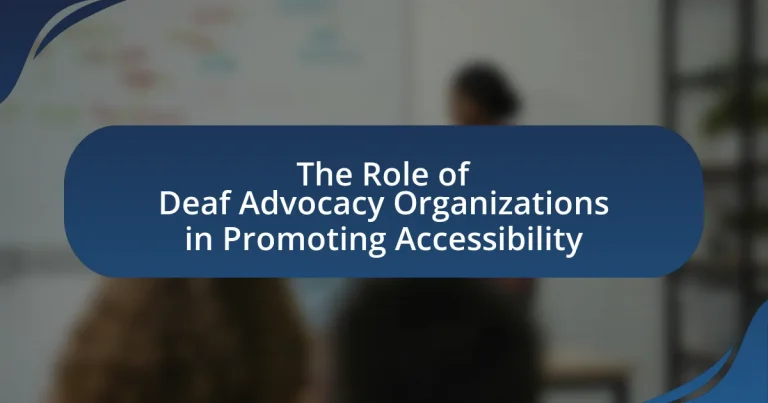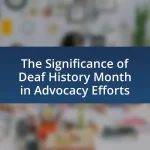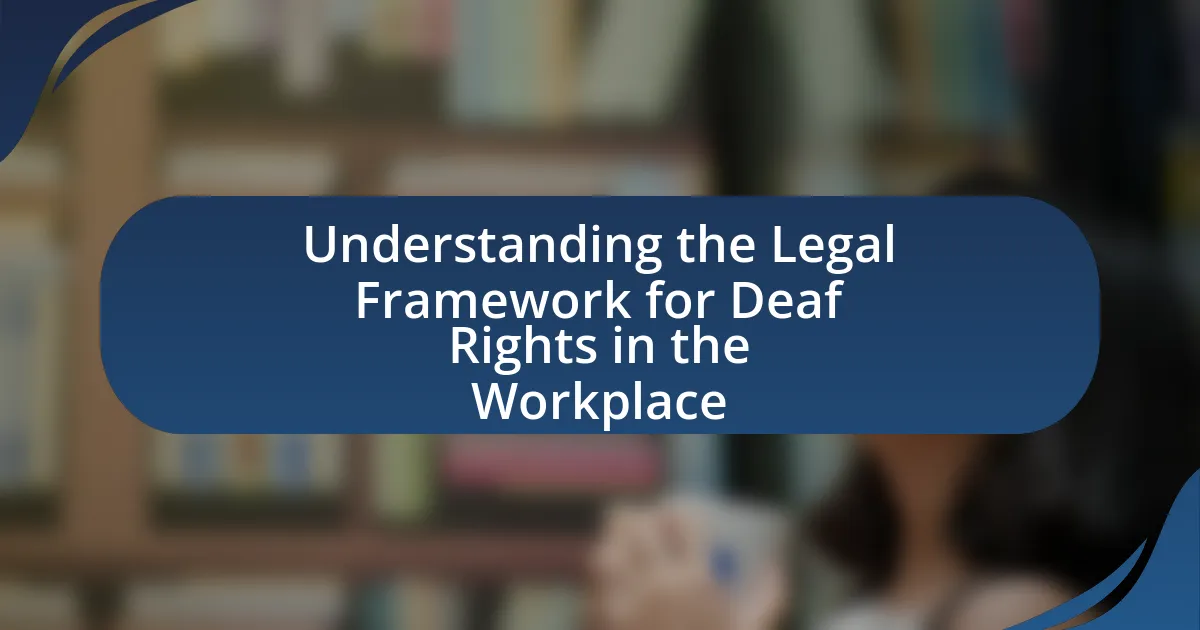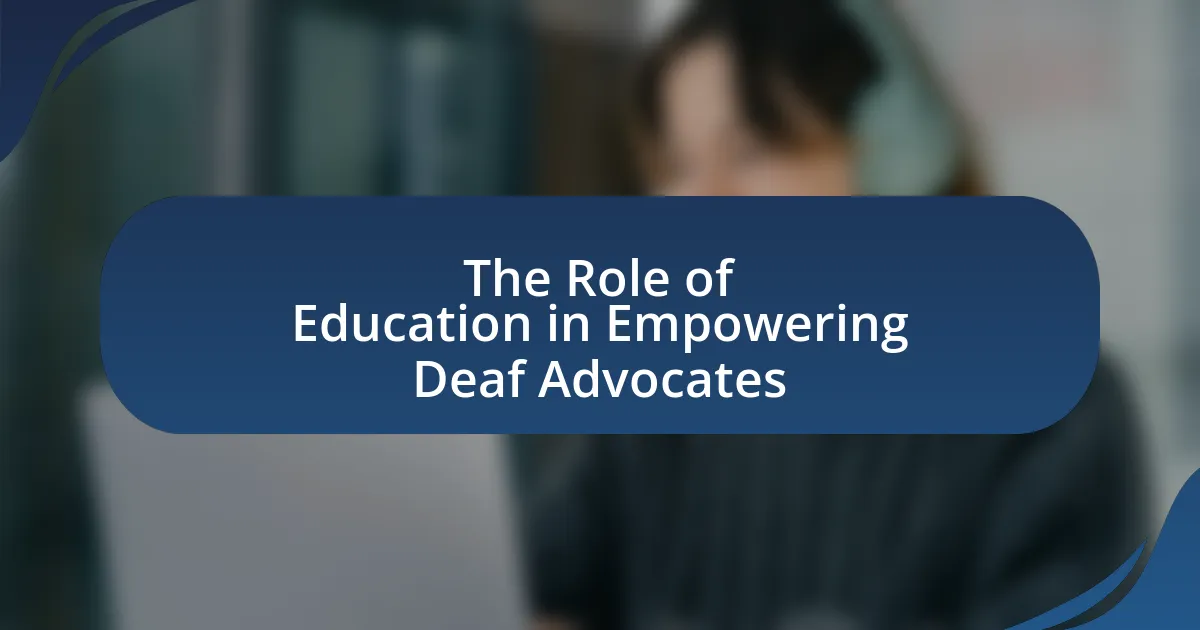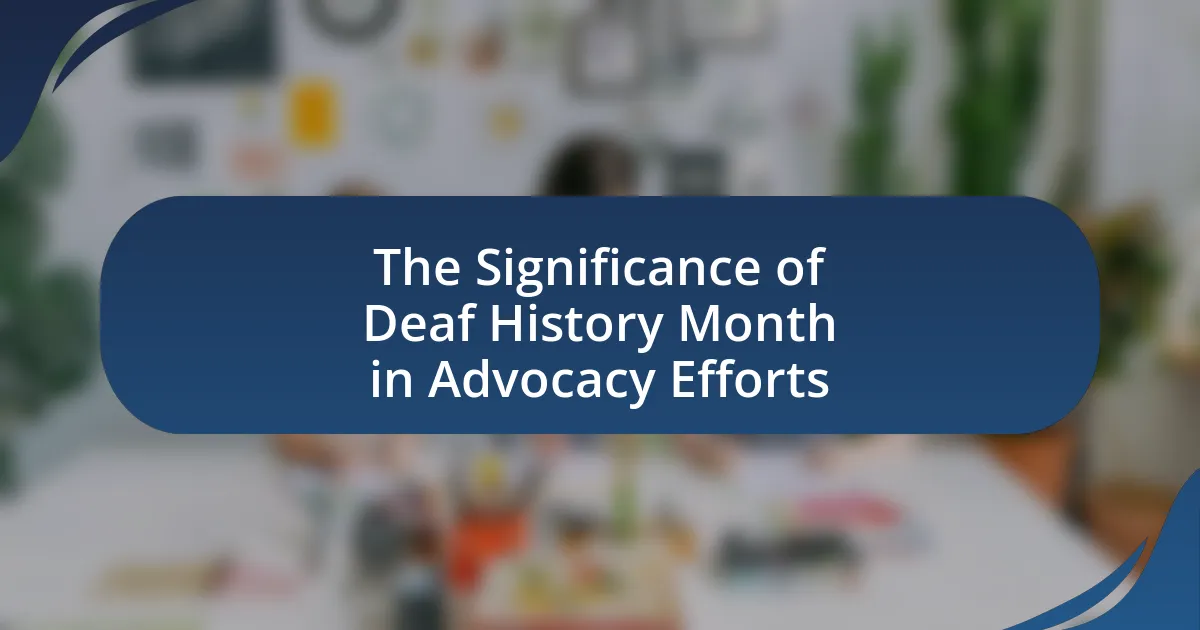Deaf advocacy organizations are essential entities that promote accessibility for Deaf individuals by advocating for their rights and ensuring equal access to services and opportunities. These organizations define accessibility as the removal of barriers to communication and participation, emphasizing the need for resources such as sign language interpreters and captioning services. Key principles of accessibility include perceivability, operability, understandability, and robustness, which apply across various environments, including education, workplaces, and public spaces. The article explores the challenges faced by these organizations, their strategies for raising awareness, and the impact of technology on enhancing accessibility efforts, ultimately highlighting the importance of community engagement and collaboration in advancing the goals of Deaf advocacy.
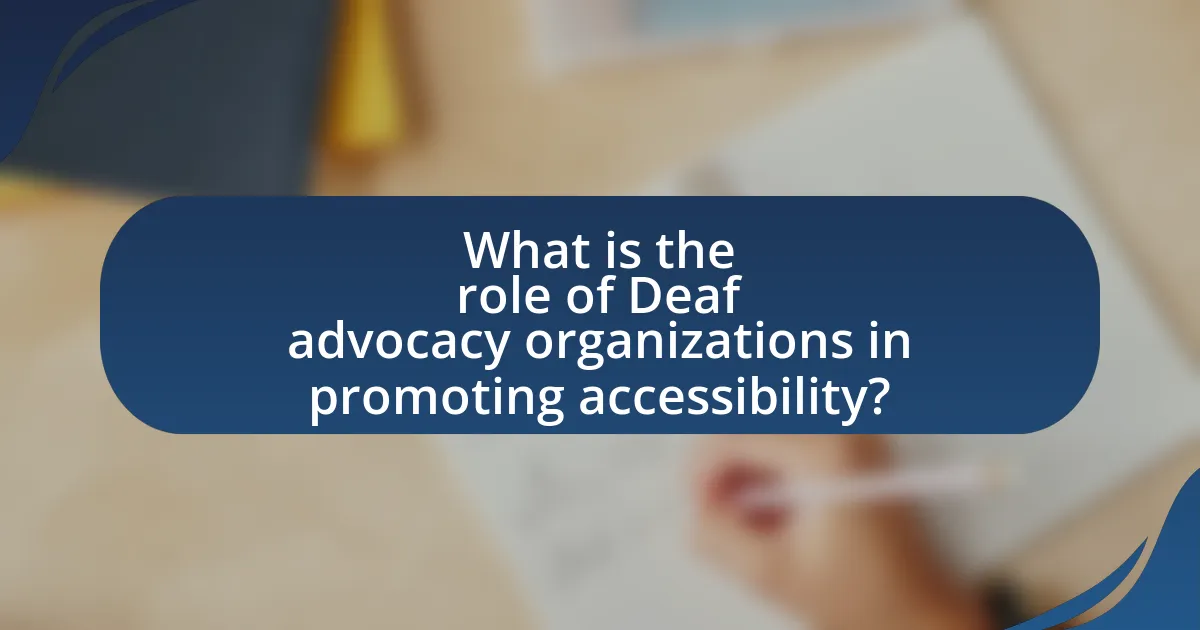
What is the role of Deaf advocacy organizations in promoting accessibility?
Deaf advocacy organizations play a crucial role in promoting accessibility by advocating for the rights of Deaf individuals and ensuring equal access to services and opportunities. These organizations work to influence policy changes, raise awareness about the needs of the Deaf community, and provide resources that facilitate communication access, such as sign language interpreters and captioning services. For instance, the National Association of the Deaf has been instrumental in lobbying for legislation like the Americans with Disabilities Act, which mandates accessibility in public spaces. Their efforts contribute to creating an inclusive environment where Deaf individuals can participate fully in society.
How do Deaf advocacy organizations define accessibility?
Deaf advocacy organizations define accessibility as the provision of equal access to information, services, and environments for individuals who are Deaf or hard of hearing. This definition emphasizes the necessity of removing barriers that hinder communication and participation, such as the availability of sign language interpreters, captioning services, and visual alerts. For instance, the National Association of the Deaf states that accessibility includes ensuring that all public spaces and digital content are designed to accommodate the needs of Deaf individuals, thereby promoting full inclusion in society.
What are the key principles of accessibility according to these organizations?
The key principles of accessibility according to deaf advocacy organizations include perceivability, operability, understandability, and robustness. Perceivability ensures that information is presented in ways that all users can perceive, such as providing captions for audio content. Operability means that all users can navigate and interact with the interface, including those who use assistive technologies. Understandability emphasizes that information and operation of the user interface must be clear and straightforward. Robustness indicates that content must be compatible with current and future user agents, including assistive technologies. These principles are foundational in creating inclusive environments for individuals with hearing impairments, as outlined in guidelines such as the Web Content Accessibility Guidelines (WCAG).
How do these principles apply to different environments?
Deaf advocacy principles apply to different environments by ensuring accessibility and inclusion for individuals with hearing impairments across various settings. In educational environments, these principles promote the use of sign language interpreters and captioning services, which enhance learning opportunities for deaf students. In workplace settings, advocacy organizations push for accommodations such as visual alert systems and accessible communication tools, which foster an inclusive work culture. Public spaces, including transportation and healthcare facilities, benefit from these principles through the implementation of visual signage and trained staff to assist deaf individuals, thereby improving overall accessibility. Research indicates that environments adhering to these principles see increased participation and satisfaction among deaf individuals, highlighting the effectiveness of advocacy efforts in diverse contexts.
Why are Deaf advocacy organizations essential for promoting accessibility?
Deaf advocacy organizations are essential for promoting accessibility because they actively work to ensure that the rights and needs of Deaf individuals are recognized and met in various environments. These organizations provide critical resources, support, and education to both the Deaf community and the public, facilitating better communication access, such as sign language interpretation and captioning services. For instance, the National Association of the Deaf has been instrumental in advocating for legislation like the Americans with Disabilities Act, which mandates accessibility in public spaces. Their efforts lead to increased awareness and implementation of accessibility standards, ultimately fostering an inclusive society for Deaf individuals.
What unique perspectives do Deaf advocacy organizations bring to the accessibility conversation?
Deaf advocacy organizations bring the perspective of lived experience and cultural identity to the accessibility conversation, emphasizing the importance of sign language and visual communication. These organizations highlight that accessibility is not merely about physical access but also about ensuring effective communication and inclusion for Deaf individuals. For instance, they advocate for the provision of sign language interpreters in public services and events, which is crucial for equal participation. Research shows that when Deaf individuals have access to sign language interpreters, their engagement in community activities increases significantly, demonstrating the direct impact of these advocacy efforts on accessibility.
How do these organizations influence policy and legislation related to accessibility?
Deaf advocacy organizations influence policy and legislation related to accessibility by actively engaging in lobbying efforts, providing expert testimony, and mobilizing community support. These organizations, such as the National Association of the Deaf, advocate for laws that ensure equal access to services and resources for individuals who are deaf or hard of hearing. For instance, they played a crucial role in the passage of the Americans with Disabilities Act (ADA) in 1990, which mandates accessibility in public spaces and services. Their efforts include drafting policy proposals, participating in public hearings, and collaborating with lawmakers to shape legislation that addresses the specific needs of the deaf community.
What challenges do Deaf advocacy organizations face in promoting accessibility?
Deaf advocacy organizations face significant challenges in promoting accessibility, primarily due to systemic barriers and societal misconceptions. These organizations often encounter resistance from institutions that are slow to implement necessary changes, such as providing sign language interpreters or accessible technology. For instance, a study by the National Association of the Deaf highlights that only 36% of public venues in the U.S. are fully accessible to Deaf individuals, indicating a widespread lack of compliance with accessibility standards. Additionally, funding limitations hinder advocacy efforts, as many organizations rely on grants and donations that may not cover all necessary initiatives. These challenges underscore the ongoing struggle for equitable access and representation within various sectors, including education, healthcare, and employment.
What are the common barriers to effective advocacy for accessibility?
Common barriers to effective advocacy for accessibility include lack of awareness, insufficient funding, and inadequate representation. Lack of awareness among policymakers and the general public often leads to neglect of accessibility issues, hindering advocacy efforts. Insufficient funding restricts the ability of advocacy organizations to implement programs and outreach initiatives, limiting their impact. Additionally, inadequate representation of disabled individuals in decision-making processes results in policies that do not fully address their needs, further obstructing effective advocacy. These barriers collectively undermine the efforts of organizations focused on promoting accessibility for the deaf and hard of hearing communities.
How do these challenges impact the Deaf community’s access to services?
Challenges such as communication barriers, lack of awareness, and insufficient resources significantly hinder the Deaf community’s access to services. These obstacles prevent effective interaction with service providers, leading to misunderstandings and inadequate support. For instance, a study by the National Association of the Deaf found that 70% of Deaf individuals reported difficulties in accessing healthcare services due to inadequate interpreter availability. This statistic underscores the critical need for advocacy organizations to address these challenges and promote accessibility, ensuring that Deaf individuals receive equitable services.
How do Deaf advocacy organizations collaborate with other stakeholders?
Deaf advocacy organizations collaborate with other stakeholders through partnerships, joint initiatives, and advocacy efforts aimed at improving accessibility and inclusion for the Deaf community. These organizations often work with government agencies, educational institutions, and private sector companies to develop policies and programs that address the specific needs of Deaf individuals. For example, the National Association of the Deaf (NAD) collaborates with federal and state governments to influence legislation that promotes equal access to services and resources. Additionally, they engage in community outreach and awareness campaigns alongside other advocacy groups to foster a more inclusive environment. This collaboration is essential for creating comprehensive solutions that enhance accessibility in various sectors, including education, employment, and healthcare.
What roles do government agencies play in supporting Deaf advocacy organizations?
Government agencies play a crucial role in supporting Deaf advocacy organizations by providing funding, policy development, and regulatory frameworks that promote accessibility. For instance, the U.S. Department of Education allocates grants to organizations that advocate for the rights of Deaf individuals, ensuring they have access to education and resources. Additionally, agencies like the Federal Communications Commission enforce regulations that require telecommunications services to be accessible, directly benefiting Deaf advocacy efforts. These actions demonstrate the government’s commitment to enhancing the quality of life for Deaf individuals through structured support for advocacy organizations.
How do partnerships with private organizations enhance accessibility efforts?
Partnerships with private organizations enhance accessibility efforts by leveraging resources, expertise, and innovative solutions to address barriers faced by individuals with disabilities. For instance, collaborations between deaf advocacy organizations and technology companies have led to the development of advanced communication tools, such as real-time captioning and video relay services, which significantly improve access to information and services for the deaf community. These partnerships often result in increased funding and support for accessibility initiatives, as evidenced by the National Association of the Deaf’s collaborations with private sector firms that have successfully implemented accessibility features in their products and services.
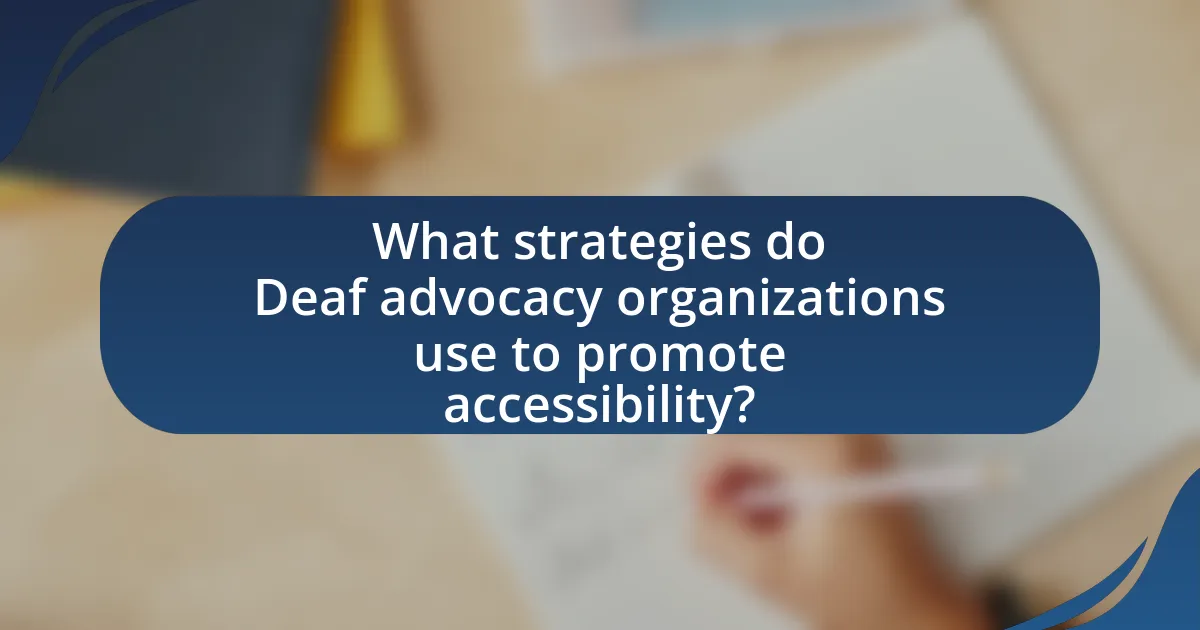
What strategies do Deaf advocacy organizations use to promote accessibility?
Deaf advocacy organizations employ various strategies to promote accessibility, including legislative advocacy, public awareness campaigns, and collaboration with service providers. Legislative advocacy involves lobbying for laws that ensure equal access to education, employment, and public services for Deaf individuals, such as the Americans with Disabilities Act (ADA) in the United States, which mandates accessibility in various sectors. Public awareness campaigns aim to educate the general public about Deaf culture and the importance of accessibility, often utilizing social media and community events to reach a broader audience. Collaboration with service providers, such as schools and healthcare facilities, ensures that they implement necessary accommodations, like sign language interpreters and captioning services, to enhance accessibility for Deaf individuals. These strategies collectively work to dismantle barriers and promote inclusivity within society.
How do Deaf advocacy organizations raise awareness about accessibility issues?
Deaf advocacy organizations raise awareness about accessibility issues through various strategies, including public campaigns, educational programs, and community engagement initiatives. These organizations often utilize social media platforms to disseminate information and share personal stories that highlight the challenges faced by Deaf individuals regarding accessibility. For instance, the National Association of the Deaf (NAD) conducts advocacy campaigns that focus on legislative changes to improve accessibility in public spaces and services. Additionally, they provide resources and training for businesses and institutions to foster inclusive environments. Research indicates that awareness campaigns significantly increase public understanding of accessibility needs, as evidenced by a 2021 study published in the Journal of Deaf Studies and Deaf Education, which found that targeted outreach improved community attitudes towards Deaf accessibility by 40%.
What types of campaigns are most effective in reaching the Deaf community?
Visual campaigns that utilize sign language and captions are most effective in reaching the Deaf community. These campaigns ensure accessibility by providing information in formats that are easily understood by Deaf individuals. Research indicates that Deaf individuals prefer visual content, as it aligns with their primary mode of communication, which is often sign language. For instance, a study published in the Journal of Deaf Studies and Deaf Education highlights that campaigns incorporating visual storytelling and sign language interpretation significantly enhance engagement and comprehension among Deaf audiences.
How do these organizations utilize social media to promote their message?
Deaf advocacy organizations utilize social media to promote their message by creating awareness, fostering community engagement, and disseminating information about accessibility issues. These organizations leverage platforms like Facebook, Twitter, and Instagram to share educational content, personal stories, and advocacy campaigns that resonate with both the deaf community and the general public. For instance, the National Association of the Deaf (NAD) frequently posts updates on legislation affecting deaf rights, encouraging followers to participate in advocacy efforts. Additionally, social media allows these organizations to connect with a broader audience, facilitating discussions and mobilizing support for initiatives aimed at improving accessibility in various sectors, such as education and employment.
What educational initiatives do Deaf advocacy organizations implement?
Deaf advocacy organizations implement educational initiatives such as awareness campaigns, workshops, and training programs aimed at promoting sign language and deaf culture. These initiatives are designed to enhance understanding and acceptance of deaf individuals within educational systems and the broader community. For example, organizations like the National Association of the Deaf (NAD) provide resources and training for educators to improve their skills in teaching deaf students, thereby fostering an inclusive learning environment. Additionally, advocacy groups often collaborate with schools to develop curricula that incorporate deaf history and culture, ensuring that deaf students receive a comprehensive education that respects their identity.
How do training programs for service providers improve accessibility?
Training programs for service providers improve accessibility by equipping them with the knowledge and skills necessary to effectively communicate and accommodate individuals with disabilities. These programs often include training on specific communication methods, such as sign language, and best practices for creating inclusive environments. Research indicates that service providers who undergo such training are more likely to implement accessibility measures, leading to increased participation of individuals with disabilities in various services. For example, a study by the National Council on Disability found that organizations with trained staff reported a 30% increase in service utilization by people with disabilities.
What resources do these organizations offer to the Deaf community?
Deaf advocacy organizations offer a variety of resources to the Deaf community, including educational programs, legal assistance, and access to interpreters. These organizations provide workshops and training sessions that enhance communication skills and promote awareness of Deaf culture. Additionally, they often advocate for policy changes that improve accessibility in public spaces and services. For instance, the National Association of the Deaf (NAD) has been instrumental in promoting legislation that ensures equal access to education and employment for Deaf individuals. Such resources are essential for empowering the Deaf community and fostering inclusion in society.
How do Deaf advocacy organizations measure their impact on accessibility?
Deaf advocacy organizations measure their impact on accessibility through various methods, including surveys, feedback from the Deaf community, and analysis of policy changes. These organizations often conduct surveys to gather data on the experiences of Deaf individuals regarding access to services and information. Feedback mechanisms, such as community forums and focus groups, allow organizations to understand specific accessibility challenges faced by Deaf individuals. Additionally, they track changes in legislation and organizational policies that enhance accessibility, providing concrete evidence of their advocacy efforts. For instance, the National Association of the Deaf reported that their advocacy led to the implementation of improved captioning standards in media, demonstrating measurable outcomes in accessibility.
What metrics are used to evaluate the success of advocacy efforts?
Metrics used to evaluate the success of advocacy efforts include policy changes, public awareness levels, stakeholder engagement, and funding increases. Policy changes reflect the effectiveness of advocacy in influencing legislation or regulations, while public awareness levels can be measured through surveys or media coverage that indicate shifts in public perception. Stakeholder engagement is assessed by the number of partnerships formed and participation rates in advocacy events. Funding increases demonstrate the financial support garnered for advocacy initiatives, often linked to successful campaigns. These metrics provide concrete evidence of the impact and effectiveness of advocacy efforts in promoting accessibility for the deaf community.
How do feedback mechanisms from the Deaf community inform future initiatives?
Feedback mechanisms from the Deaf community directly inform future initiatives by providing essential insights into their specific needs and preferences. Deaf advocacy organizations utilize surveys, focus groups, and community forums to gather input, ensuring that initiatives are tailored to enhance accessibility and inclusivity. For instance, the National Association of the Deaf regularly conducts surveys to assess the effectiveness of communication access in various settings, which has led to improved policies and practices in education and employment. This data-driven approach validates the importance of community feedback in shaping initiatives that genuinely reflect the experiences and requirements of Deaf individuals.
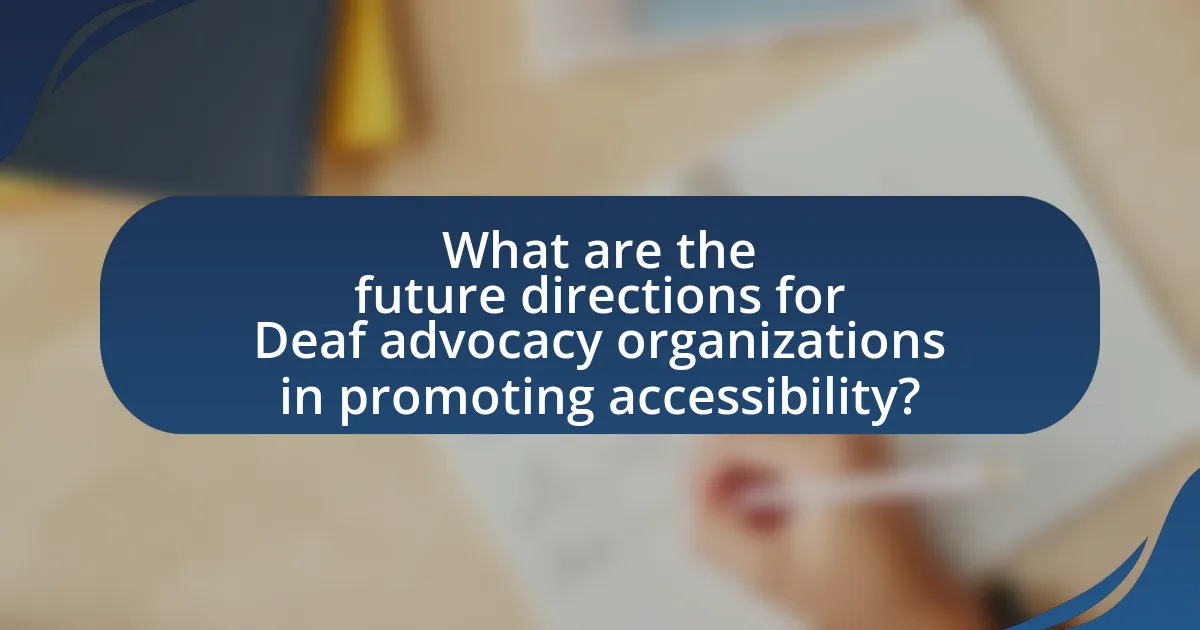
What are the future directions for Deaf advocacy organizations in promoting accessibility?
Future directions for Deaf advocacy organizations in promoting accessibility include enhancing digital accessibility, advocating for policy changes, and increasing community engagement. Organizations are focusing on improving access to technology, such as video relay services and captioning, which are essential for effective communication. Additionally, they are pushing for legislative reforms that ensure compliance with accessibility standards in public spaces and services. Community engagement initiatives aim to raise awareness about the needs of Deaf individuals, fostering a more inclusive society. These strategies are supported by data indicating that improved accessibility leads to better educational and employment outcomes for Deaf individuals, highlighting the importance of ongoing advocacy efforts.
How can technology enhance the efforts of Deaf advocacy organizations?
Technology can enhance the efforts of Deaf advocacy organizations by improving communication access and raising awareness about Deaf culture and rights. For instance, video relay services (VRS) allow Deaf individuals to communicate with hearing people through sign language interpreters, significantly increasing accessibility in various settings. Additionally, social media platforms enable advocacy organizations to reach broader audiences, disseminate information quickly, and mobilize support for policy changes. Research indicates that the use of mobile applications designed for Deaf users can facilitate real-time communication and provide resources, further empowering the community. These technological advancements not only foster inclusivity but also strengthen the advocacy efforts of organizations dedicated to promoting accessibility for Deaf individuals.
What emerging technologies are being utilized to improve accessibility?
Emerging technologies utilized to improve accessibility include artificial intelligence, augmented reality, and speech recognition systems. Artificial intelligence enhances accessibility by providing real-time captioning and translation services, making content more accessible to individuals with hearing impairments. Augmented reality applications can overlay visual information in real-world environments, aiding navigation and understanding for those with visual impairments. Speech recognition systems convert spoken language into text, facilitating communication for individuals who are deaf or hard of hearing. These technologies are increasingly integrated into various platforms, demonstrating their effectiveness in promoting accessibility for diverse user needs.
How can Deaf advocacy organizations leverage technology for outreach?
Deaf advocacy organizations can leverage technology for outreach by utilizing social media platforms, video conferencing tools, and mobile applications to enhance communication and engagement with the Deaf community. For instance, organizations can create content in sign language and share it on platforms like Facebook, Instagram, and YouTube, which have proven effective in reaching wider audiences. According to a study by the Pew Research Center, 69% of adults in the U.S. use social media, making it a vital tool for advocacy and information dissemination. Additionally, video conferencing tools like Zoom enable organizations to host virtual meetings and workshops, fostering community involvement and education. Mobile applications can also provide resources and information directly to users, increasing accessibility and awareness of Deaf issues.
What role does community engagement play in the future of accessibility advocacy?
Community engagement is crucial for the future of accessibility advocacy as it fosters collaboration between individuals with disabilities and advocacy organizations. This collaboration ensures that the voices of those affected by accessibility issues are heard, leading to more effective and relevant advocacy efforts. Research indicates that inclusive community engagement strategies can enhance the development of policies and practices that directly address the needs of people with disabilities, thereby improving accessibility outcomes. For instance, the National Council on Disability emphasizes that community-driven initiatives lead to better identification of barriers and more innovative solutions, ultimately advancing the goals of accessibility advocacy.
How can Deaf advocacy organizations foster stronger community ties?
Deaf advocacy organizations can foster stronger community ties by actively engaging in outreach programs that promote awareness and understanding of Deaf culture and communication. These organizations can host community events, workshops, and educational sessions that encourage interaction between Deaf individuals and hearing community members, thereby breaking down barriers and fostering inclusivity. For instance, research indicates that community engagement initiatives, such as sign language classes and Deaf awareness days, significantly enhance mutual understanding and respect, leading to stronger social connections. By facilitating these interactions, Deaf advocacy organizations not only empower Deaf individuals but also enrich the broader community, creating a more inclusive environment for all.
What strategies can be employed to involve more Deaf individuals in advocacy efforts?
To involve more Deaf individuals in advocacy efforts, organizations should implement strategies such as increasing accessibility to information through sign language interpretation and providing resources in accessible formats. Research indicates that when advocacy materials are available in sign language, Deaf individuals are more likely to engage and participate actively in advocacy initiatives. For example, the National Association of the Deaf emphasizes the importance of accessible communication in fostering participation, highlighting that 90% of Deaf individuals prefer information presented in their native language, which is often sign language. Additionally, creating mentorship programs that connect experienced advocates with new participants can enhance involvement, as evidenced by successful initiatives in various Deaf communities that have led to increased representation and advocacy engagement.
What practical steps can individuals take to support Deaf advocacy organizations?
Individuals can support Deaf advocacy organizations by volunteering their time and skills to assist in various initiatives. Engaging in activities such as organizing events, fundraising, or providing administrative support directly contributes to the operational capacity of these organizations. Additionally, individuals can donate financially, as many Deaf advocacy organizations rely on contributions to fund their programs and outreach efforts.
Promoting awareness about Deaf issues through social media or community events also plays a crucial role in increasing visibility and support for these organizations. By sharing information and resources, individuals can help educate others about the challenges faced by the Deaf community, thereby fostering a more inclusive environment.
Furthermore, advocating for policy changes that benefit the Deaf community, such as improved accessibility standards, can significantly impact the effectiveness of advocacy organizations. Engaging with local representatives and participating in campaigns can amplify the voices of Deaf individuals and support the mission of these organizations.
These practical steps not only enhance the capacity of Deaf advocacy organizations but also contribute to a broader societal understanding and acceptance of Deaf culture and rights.
How can community members contribute to accessibility initiatives?
Community members can contribute to accessibility initiatives by actively participating in advocacy efforts, providing feedback on accessibility needs, and volunteering for organizations focused on improving access for individuals with disabilities. Their involvement can lead to more inclusive policies and practices, as evidenced by studies showing that community engagement enhances the effectiveness of accessibility programs. For instance, the National Council on Disability reported that community-driven initiatives often result in better resource allocation and increased awareness of accessibility issues.
What are the best practices for collaborating with Deaf advocacy organizations?
The best practices for collaborating with Deaf advocacy organizations include ensuring effective communication, respecting cultural norms, and involving Deaf individuals in decision-making processes. Effective communication can be achieved by providing sign language interpreters and accessible materials, which fosters an inclusive environment. Respecting cultural norms involves understanding the values and experiences of the Deaf community, which can enhance trust and collaboration. Involving Deaf individuals in decision-making processes ensures that their perspectives and needs are prioritized, leading to more effective advocacy outcomes. These practices are supported by research indicating that inclusive collaboration leads to better accessibility initiatives and community engagement.
